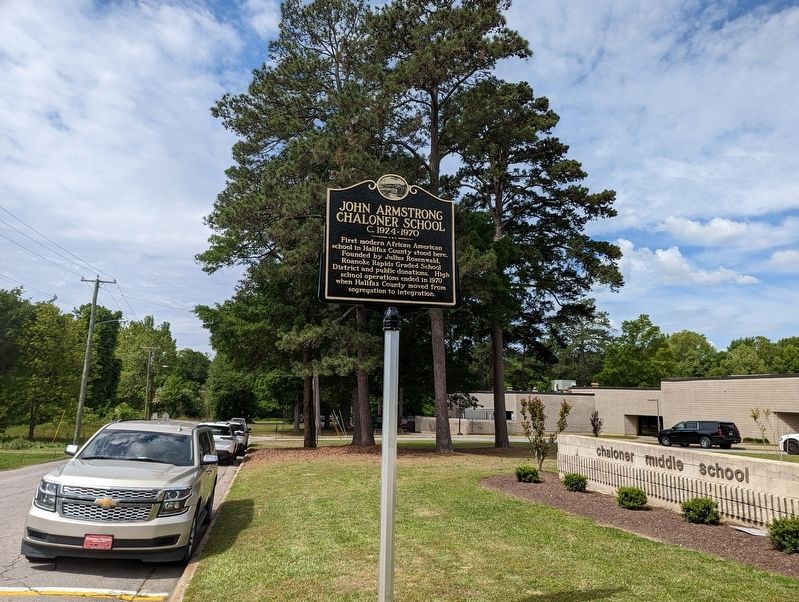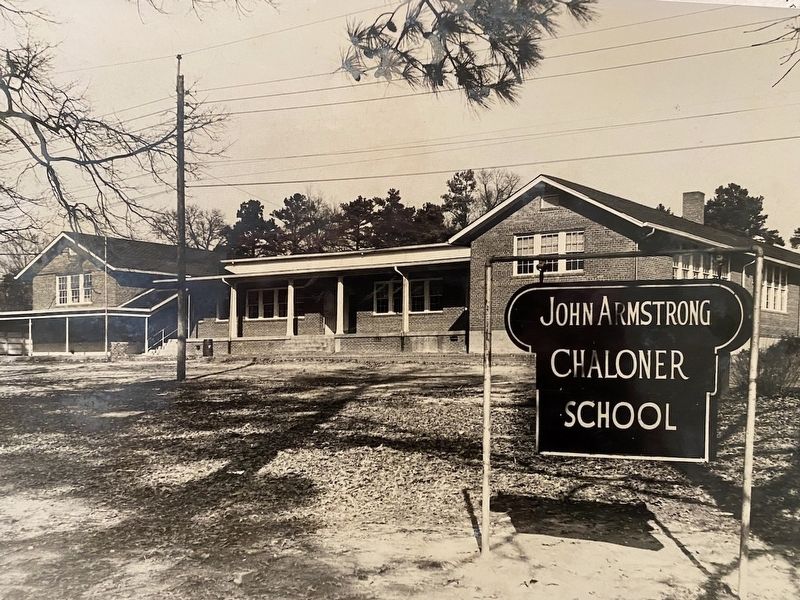Roanoke Rapids in Halifax County, North Carolina — The American South (South Atlantic)
John Armstrong Chaloner School
C. 1924-1970
Erected 2023.
Topics. This historical marker is listed in these topic lists: African Americans • Education. A significant historical year for this entry is 1970.
Location. 36° 26.451′ N, 77° 39.531′ W. Marker is in Roanoke Rapids, North Carolina, in Halifax County. Marker is at the intersection of Virginia Avenue and Poplar Street, on the left when traveling north on Virginia Avenue. Located in front of Chaloner Middle School. Touch for map. Marker is at or near this postal address: 2100 Virginia Ave, Roanoke Rapids NC 27870, United States of America. Touch for directions.
Other nearby markers. At least 8 other markers are within 2 miles of this marker, measured as the crow flies. Closing The Circle (about 800 feet away, measured in a direct line); Keys v. Carolina Coach Company (approx. 0.9 miles away); Andrew Joyner (approx. 1.2 miles away); Roanoke Rapids High School (approx. 1.3 miles away); Afghanistan & Iraq Memorial (approx. 1.4 miles away); Lest We Forget (approx. 1.4 miles away); Veterans Memorial (approx. 1.4 miles away); Korea/Vietnam (approx. 1.4 miles away). Touch for a list and map of all markers in Roanoke Rapids.
Also see . . .
1. John Armstrong Chaloner.
John Armstrong Chaloner, author, industrialist, and philanthropist, was born in New York City in the home of his maternal ancestors, the prominent Astor family. The family name, originally spelled Chaloner, was first brought to America by the Reverend Isaac Chanler, a Baptist clergyman who migrated to Charleston, S.C., from Bristol, England, in 1710. Chanler's grandson, the Reverend John White Chanler, who was ordained in the Episcopal church, married Elizabeth Winthrop, the daughter of Benjamin and Judith Stuyvesant Winthrop, descended respectively from the first colonial governors of Massachusetts and New Amsterdam. His son, John Winthrop Chanler, married in 1861 Margaret Astor Ward, the only child of Emily Astor and Samuel Ward, the original "Uncle Sam" of American folklore. After the death of her mother, Margaret Astor Ward was reared by her grandfather, William Backhouse Astor, who declined to entrust his infant granddaughter to a son-in-law whom he considered unworthy of managing an Astor and, more especially, an Astor's fortune. The Astor family approved of her marriage to Chanler, a promising young New York lawyer. Although his family lacked the huge fortune of the Astors, by birth, education, social position, and personality he was an acceptable match for an Astor heiress. Elected as a Democrat to Congress in 1862, he served for three terms until his opposition to Boss Tweed of Tammany Hall cost him the support of his party in 1868. He never again sought public office, but he did remain active in party affairs and participated in the rehabilitation of the Democratic organization following the overthrow of its corrupt leadership.(Submitted on May 5, 2023, by Michael Buckner of Durham, North Carolina.)
2. Rosenwald Schools in North Carolina.
In the early 1900s, black education was neglected by the government of North Carolina. The state was segregated by race in every public area and schools were no exception. Many of the state’s leaders were avowed white supremacists. They underfunded white schools, but black schools received even less than their white counterparts. Many rural areas were nearly without schooling for black students. The Rosenwald Fund was created to ease this problem. Rosenwald schools were institutions for black students built with a combination of Northern philanthropy and funds raised by black activists on the local level. More than 800 schools were built in North Carolina, more than in any other state. By building schools and supporting teachers, the Rosenwald Fund helped to transform the prospects of black students and education in North Carolina.(Submitted on May 5, 2023, by Michael Buckner of Durham, North Carolina.)
Credits. This page was last revised on May 8, 2023. It was originally submitted on May 5, 2023, by Michael Buckner of Durham, North Carolina. This page has been viewed 70 times since then and 29 times this year. Photos: 1, 2. submitted on May 5, 2023, by Michael Buckner of Durham, North Carolina. • Bernard Fisher was the editor who published this page.

